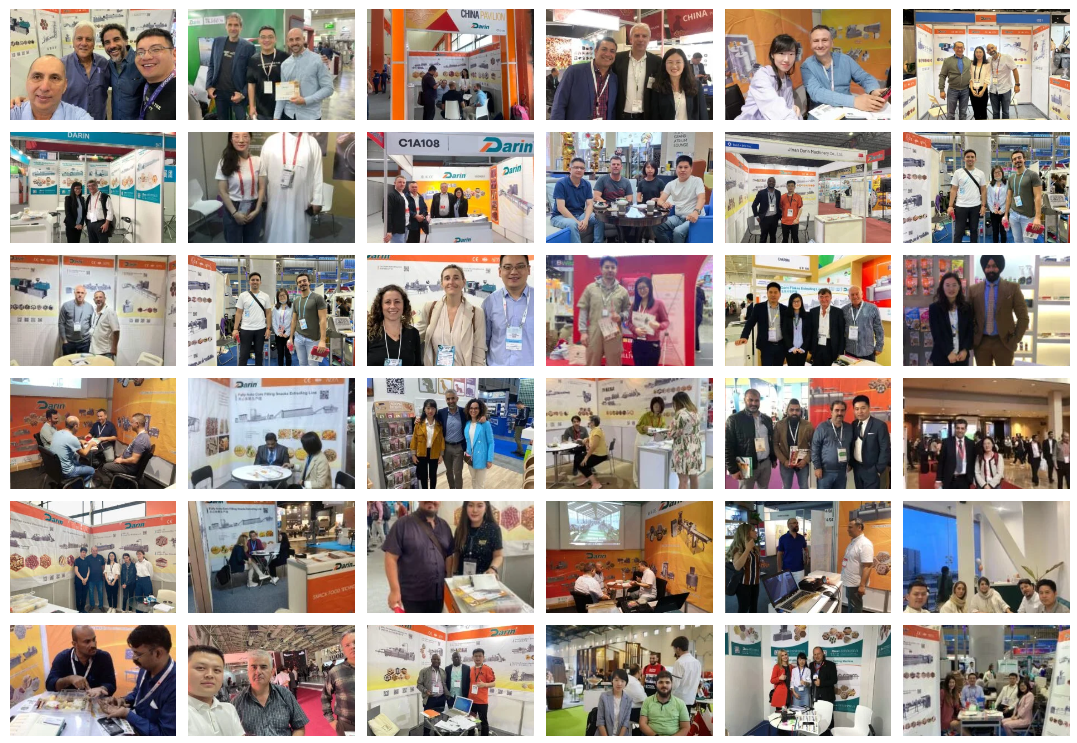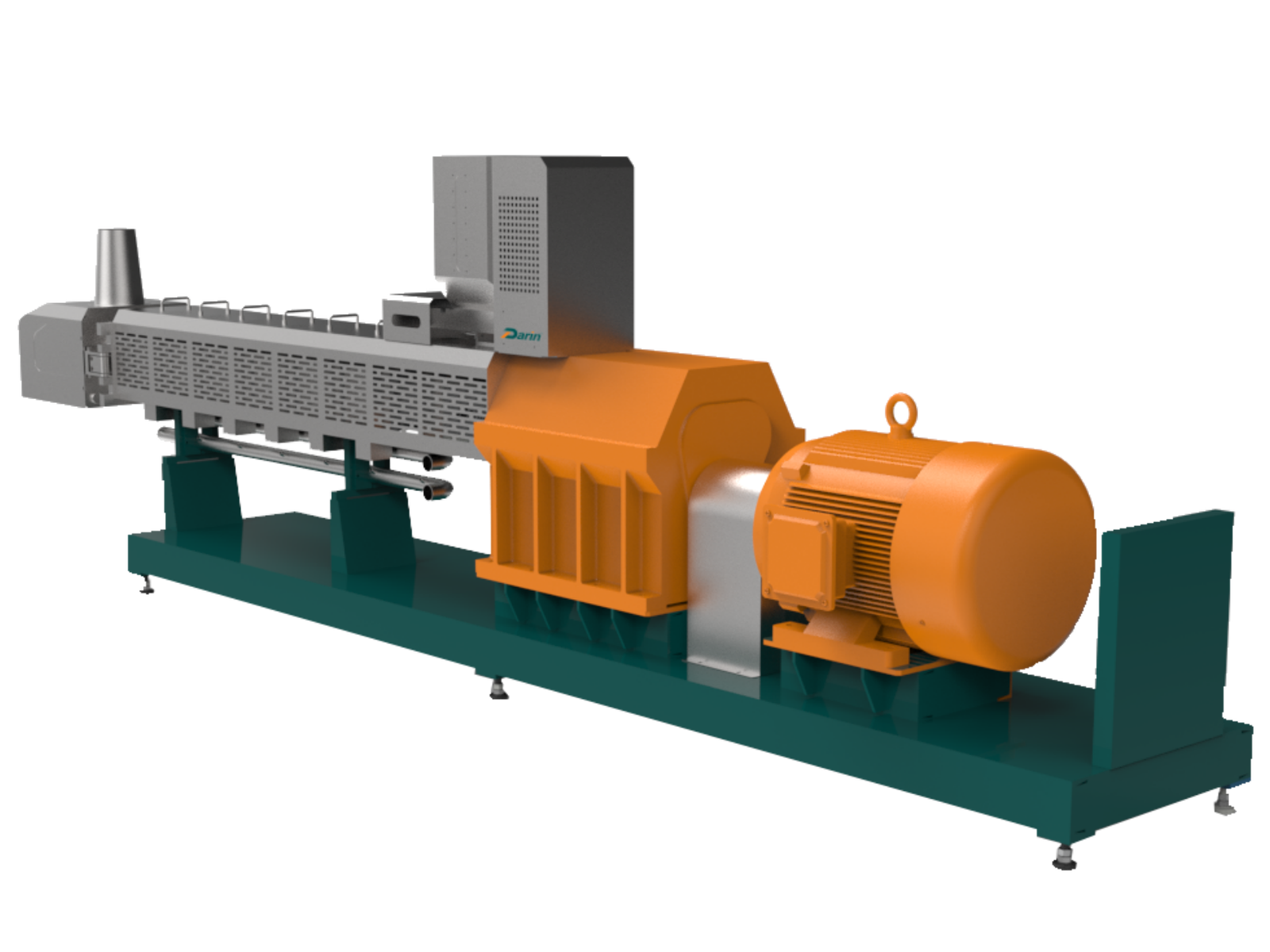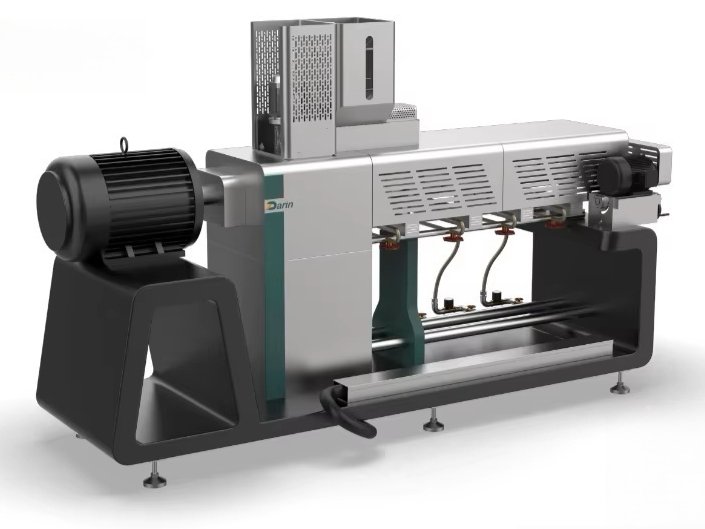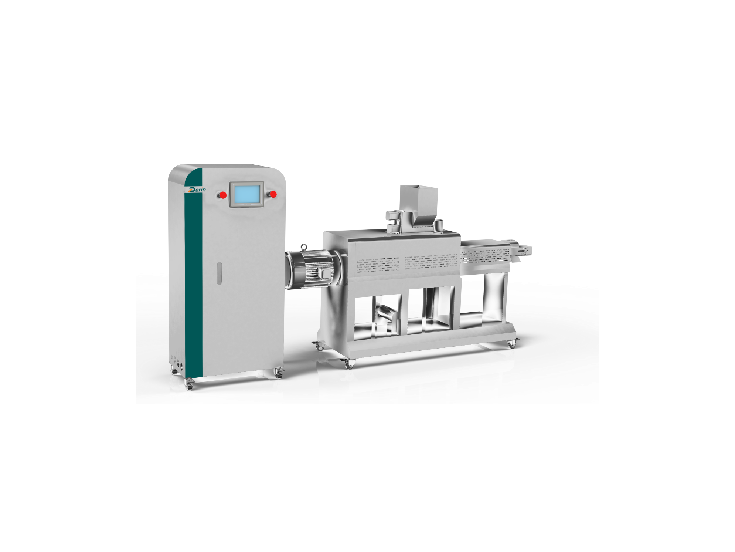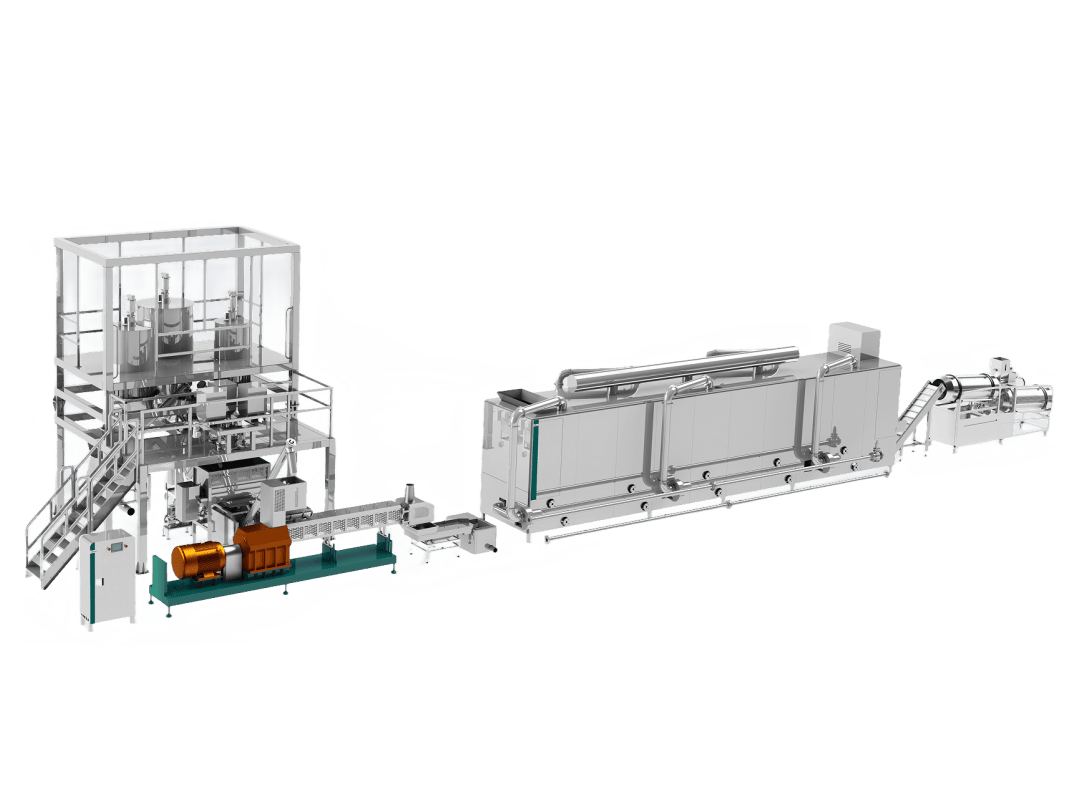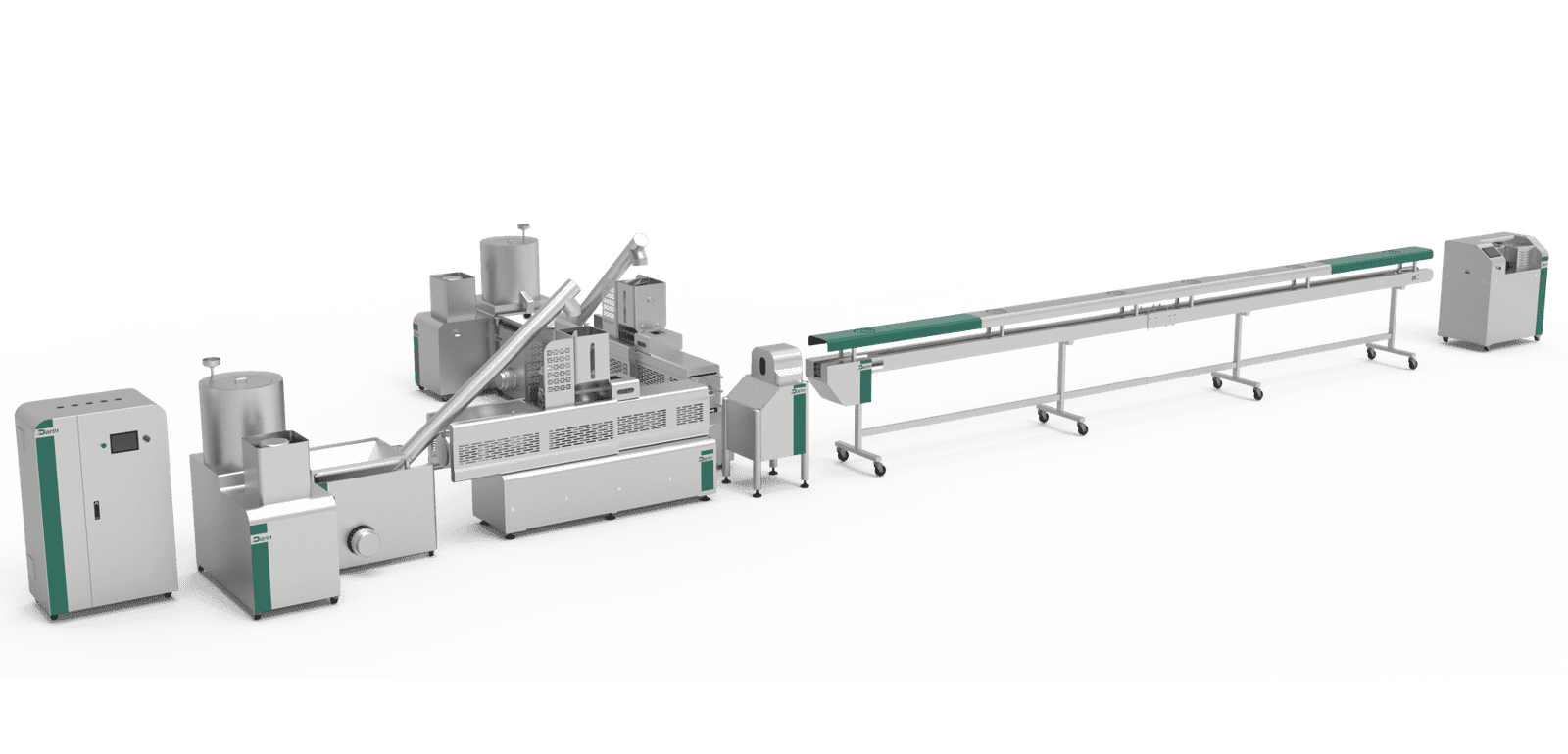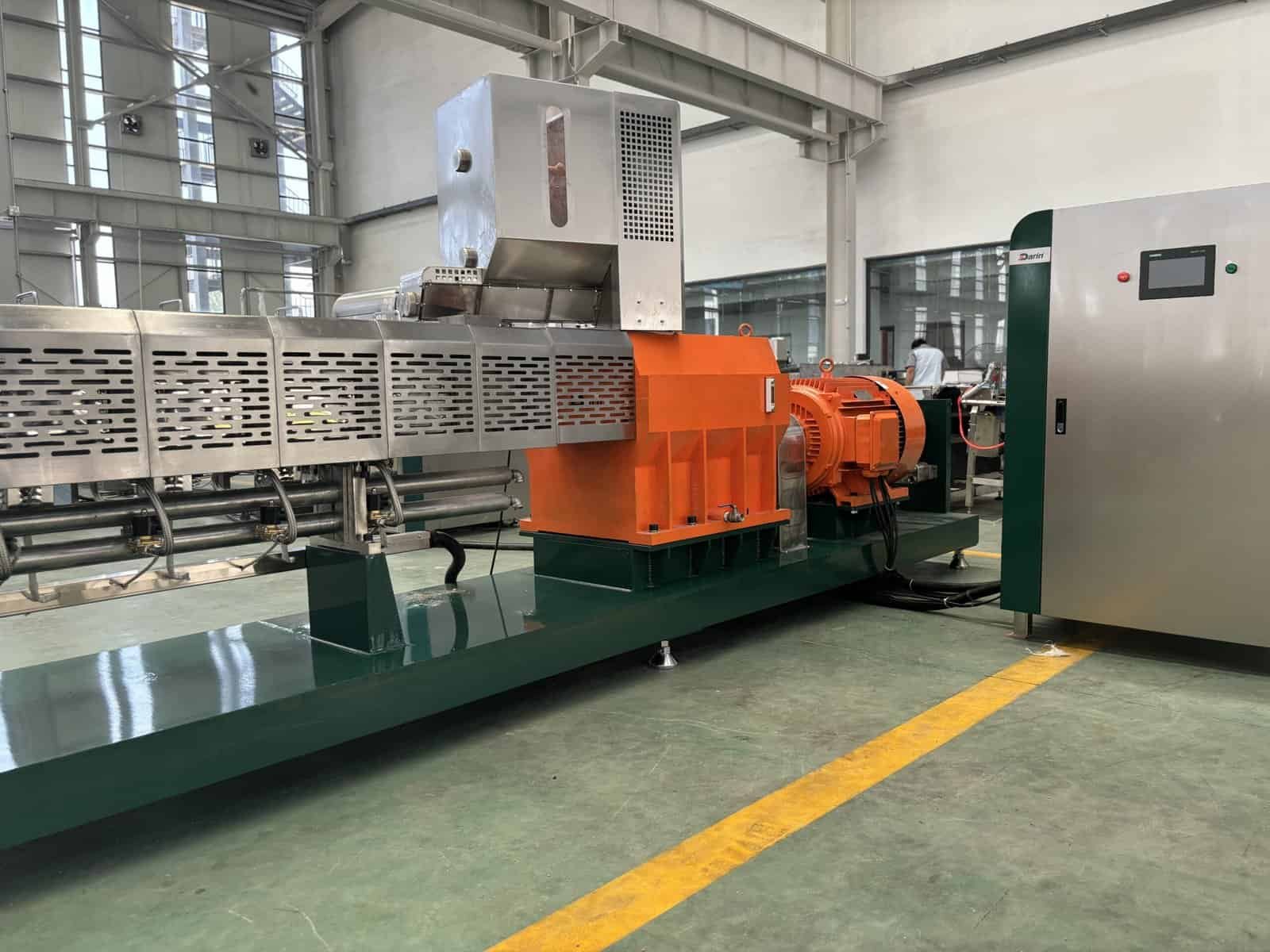
In the modern food industry, efficiency, flexibility, and creativity define competitiveness. Yet, many small producers, startups, and research centers face the same frustrating challenge — how to produce innovative, high-quality snacks, cereals, or pet foods without investing in massive industrial plants. Traditional extrusion systems are large, expensive, and require significant floor space and utilities. The result? Many ideas never reach the market because development and testing are too costly or complicated.
This is where small food extruder machines make a real difference. Designed for pilot-scale production, startups, and small manufacturers, these compact extruders combine industrial-level technology with cost-effective performance. They allow operators to transform raw powders and grains into shaped, cooked, and expanded food products using heat, pressure, and mechanical shear — all within a single system.
A small food extruder machine is a compact, automated device that processes mixed food materials (like cereals, starches, proteins, or pet food ingredients) through a rotating screw barrel under heat and pressure, converting them into cooked, shaped, and expanded products such as snacks, breakfast cereals, pasta, or pet treats. It works by mixing, heating, compressing, and forcing the material through a die, where sudden pressure drop causes expansion and texture formation.
For anyone planning to start or expand a food manufacturing project, mastering the working principle of a small extruder is essential. Understanding how raw powders become puffed, textured, or molded through controlled mechanical and thermal processes helps manufacturers achieve consistent quality, save costs, and create new market-ready products.
A small food extruder can only be used for pet food production.False
Small food extruders are multi-purpose systems suitable for human snacks, cereals, pasta, and pet feed. Their versatility depends on die design, screw configuration, and recipe formulation.
The heat in extrusion comes mainly from external heaters.False
In small extruders, most heat is generated by internal mechanical shear and friction, while heaters stabilize temperature in each zone.
Twin-screw extruders mix ingredients more uniformly than single-screw types.True
Twin-screw extruders provide superior mixing, pressure stability, and flexibility for complex formulations or textured protein production.
Step-by-Step: The Technical Working Principles of a Small Food Extruder
The extrusion process is a continuous thermo-mechanical cooking system, transforming powders into ready-to-eat or ready-to-dry foods.
Below are the first five critical stages of how the process unfolds inside a small food extruder machine.
Step 1: Raw Material Preparation
This stage determines the foundation of your final product. The operator selects and blends key raw materials such as corn flour, rice flour, soy protein, wheat starch, or fish meal depending on the product type — human food or pet feed.
Moisture is adjusted between 10% and 20%, enabling smooth feeding and efficient cooking.
Typical Formulation Examples
| Product Type | Major Ingredients | Function | Typical Ratio (%) |
|---|---|---|---|
| Puffed snacks | Corn flour, rice flour, wheat starch | Provide starch for expansion | 60–70 |
| Breakfast cereal | Corn grits, wheat flour, sugar, malt | Texture, color, and flavor | 50–65 |
| Pet food (dog/cat) | Corn meal, meat powder, soy meal | Protein and starch base | 40–55 |
| Fish feed | Wheat flour, fish meal, soybean meal | Floatability and protein | 35–50 |
| Nutritional pasta | Wheat semolina, starch, vitamins | Elasticity and nutrition | 90–100 |
A Darin DR-65 extruder uses a pre-mixing system where all ingredients are evenly blended in a horizontal ribbon mixer before feeding. This ensures uniform moisture distribution and consistent extrusion pressure later in the process.
Step 2: Feeding System
After mixing, the dry blend is transferred into the screw feeder. Feeding rate stability is crucial: underfeeding can cause air pockets, while overfeeding leads to clogging and pressure fluctuation.
Darin small extruders (e.g., DR-52 and DR-65) employ variable-frequency drive feeders to precisely control feeding speed, adapting automatically to formulation density.
Typical feeding rates:
- Laboratory DR-52: 15–50 kg/h
- Industrial DR-70: 150–250 kg/h
- Heavy-duty DR-85: 300–500 kg/h
Feeding must remain continuous, matching the extrusion screw’s throughput to maintain steady cooking and pressure balance inside the barrel.
Step 3: Extrusion and Cooking Inside the Barrel
This is the heart of the process. Inside the barrel, ingredients are mixed, heated, sheared, and compressed by the rotating screw(s).
Temperatures typically range from 100°C to 200°C, and internal pressure reaches 2–5 MPa.
As the screw conveys material forward:
- Mechanical friction generates shear heat.
- Starch gelatinizes and proteins denature.
- Water within the mixture becomes superheated steam.
- The structure changes from granular to viscoelastic melt.
Barrel Zoning Example (DR-70 Twin-Screw Extruder)
| Zone | Function | Typical Temperature (°C) |
|---|---|---|
| Feeding zone | Material intake and compression start | 60–90 |
| Compression zone | Cooking and kneading | 120–150 |
| High-pressure zone | Final gelatinization and shaping pressure | 160–190 |
| Metering zone | Flow stabilization before die | 180–200 |
The twin-screw configuration ensures uniform shear, minimal backflow, and greater formulation flexibility — ideal for high-protein or fiber-enriched products.
Step 4: Die and Shaping
Once the cooked material exits the screw barrel, it’s pushed through a shaping die.
The die defines the product’s geometry, density, and expansion. At this point, the material is still under high pressure and temperature. Upon exiting the die, the sudden pressure drop causes instantaneous expansion — forming airy, crispy textures for snacks or compact kibbles for pet food.
Common Die Configurations
| Product Type | Die Shape | Expansion Ratio | Output Texture |
|---|---|---|---|
| Puffed snacks | Star, ring, curl, ball | 2.5–3.5× | Crispy, hollow |
| Pet food | Round, bone, heart, triangle | 1.2–2.0× | Firm, uniform |
| Breakfast cereal | Circle, ring, letter shape | 2.0–3.0× | Light, crunchy |
| Pasta | Tube, shell, ribbon | Non-expanded | Dense, elastic |
Darin provides CNC-machined interchangeable dies, allowing quick shape changes between snack, cereal, or pet food formats — ideal for multi-product plants.
Step 5: Cutting System
Immediately after shaping, a rotary cutter trims the extrudate into precise lengths.
Cutting speed and blade type influence texture and product size. For instance:
- Low cutting speed → long curls (snacks)
- High cutting speed → short kibbles or pellets (pet food)
Cutting blades can be stainless-steel circular or saw-tooth, powered by independent motors synchronized with the main extruder drive.
The Darin DR-65 line integrates adjustable rotary cutters that can shift from 0 to 1200 rpm for maximum flexibility in particle size and shape.
Step 6: Drying — Stabilizing Product Moisture and Texture
Once the extrudate is shaped and cut, it contains 15–25% moisture, which makes it soft and unstable. To ensure crispness, shelf stability, and microbial safety, it must be dried immediately.
Drying transforms the hot, expanded extrudate into a solid, low-moisture product.
Most small food production lines from Darin Machinery use electric or gas-heated belt dryers. These are continuous systems with temperature-controlled zones, where hot air flows across a moving mesh belt.
Typical drying parameters:
| Parameter | Typical Range | Description |
|---|---|---|
| Air temperature | 90–120°C | Evaporates moisture evenly |
| Retention time | 10–30 min | Depends on thickness and expansion |
| Final moisture | 8–12% | Ideal for crisp texture and long shelf life |
| Airflow type | Cross or counterflow | Balances drying efficiency |
For human snack foods, slightly lower final moisture (7–9%) gives a crunchy texture. For pet food, higher moisture (10–12%) helps retain palatability and reduces brittleness.
Uniform drying prevents cracking or over-browning. Darin’s dryers include adjustable belts and multi-layer configurations for energy-efficient heat distribution.
Step 7: Flavoring and Coating — Taste, Nutrition, and Market Appeal
After drying, the product enters the flavoring and coating system. This step defines the sensory profile—taste, aroma, and color—especially for snack or pet food applications.
For human food:
Products are often coated with oil, sugar syrup, cheese powder, or seasoning blends.
For pet food:
Palatants (meat-based flavor coatings), vitamins, and functional additives (like omega-3 or probiotics) are applied.
The coating process can be dry (powder flavor drum) or wet (oil sprayer + drum mixer).
Darin flavoring systems use rotating stainless drums with atomized sprayers to ensure even coverage and minimal waste.
Typical Coating Additives
| Type | Ingredient | Function |
|---|---|---|
| Oil | Chicken fat, sunflower oil | Palatability and shine |
| Dry flavor | Cheese powder, BBQ mix | Taste enhancement |
| Nutrient additive | Vitamins, minerals | Health benefits |
| Colorant | Caramel, paprika | Appearance consistency |
Coating also affects texture recovery—a light oil layer preserves crispness by sealing out humidity.
Step 8: Cooling and Packaging — Locking in Quality
Freshly flavored products must be cooled before packaging to prevent condensation inside sealed bags.
Darin uses cooling conveyors that blow ambient or chilled air across the product, reducing temperature from ~80°C to 25–30°C.
Once cooled, automatic packaging systems weigh and seal the product into bags, jars, or pouches. For pet food, nitrogen flushing is often used to prevent oxidation.
Common Packaging Formats
| Product | Packaging Type | Advantage |
|---|---|---|
| Puffed snacks | Pillow bag / canister | Attractive for retail |
| Breakfast cereal | Laminated pouch / box | Moisture barrier |
| Pet food | Multi-layer bag with zipper | Extended shelf life |
| Pasta | Polybag / paper box | Simple and eco-friendly |
Step 9: Quality Control — Ensuring Consistency
Each batch undergoes quality testing to ensure safety, uniformity, and performance.
Key quality metrics include moisture content, density, expansion, and appearance.
Standard QC Parameters
| Parameter | Ideal Range | Method |
|---|---|---|
| Moisture content | 8–12% | Oven drying |
| Bulk density | 0.12–0.25 g/cm³ | Volume measurement |
| Expansion ratio | 2.0–3.5× | Caliper reading |
| Protein denaturation | ≥85% | Kjeldahl method |
| Color uniformity | Visual | Digital imaging |
| Oil content (coated) | 4–8% | Soxhlet extraction |
Advanced small extruders like Darin DR-70 use PLC monitoring systems that track torque, pressure, and temperature in real-time, alerting operators to anomalies before they affect quality.
Step 10: Cleaning and Maintenance — Keeping the System Reliable
Proper maintenance ensures safety, hygiene, and long machine life.
Small extruders are designed for quick disassembly, allowing fast cleaning between recipes or product types.
Key maintenance steps:
- Stop the extruder and remove die and screw when cooled.
- Flush the barrel with warm water or a mild cleaning compound.
- Dry all stainless parts thoroughly to prevent corrosion.
- Lubricate bearings and gears according to manufacturer schedule.
- Inspect temperature sensors and PLC control functions monthly.
For small-scale producers, Darin offers training programs on preventive maintenance and sanitation, ensuring operators maintain compliance with HACCP and CE food safety standards.
Understanding the Interplay of Temperature, Pressure, and Moisture
The extrusion process relies on the thermo-mechanical balance among three critical variables:
| Variable | Typical Range | Influence on Product |
|---|---|---|
| Temperature | 100–200°C | Controls starch gelatinization and expansion |
| Pressure | 2–5 MPa | Determines density and shaping force |
| Moisture | 10–20% | Balances expansion and binding strength |
When properly synchronized, these conditions create a stable, uniform matrix. If one deviates—e.g., excessive moisture or low temperature—product expansion decreases, texture becomes dense, and die blockage can occur.
Darin extruders utilize PID temperature control and frequency-adjusted screw speed (typically 150–600 rpm) to maintain the ideal balance dynamically.
Understanding the Structure of a Small Food Extruder Machine
A small food extruder may appear compact, but internally it’s an advanced system integrating mechanical, electrical, and thermal technologies. Each subsystem plays a key role in transforming dry powders into fully cooked, expanded products.
1. Feeding System
- Function: Supplies raw material steadily into the barrel.
- Key Components: Hopper, variable-speed screw feeder, feed control sensor.
- Design Features: Made of SUS304 stainless steel, sealed to prevent contamination.
- Darin Highlight: All Darin feeders use frequency converters to synchronize with main motor torque for stable throughput.
2. Extrusion Barrel
- Function: The processing chamber where heating, mixing, and cooking occur.
- Material: Alloy steel or stainless steel with nitride-hardened liners for wear resistance.
- Structure: Composed of several modular sections (feeding, compression, cooking, and metering).
- Heating Method: Electric resistance heaters or steam jackets, with PID temperature control.
- Cooling: Water jackets in feed zones maintain stable input temperature.
3. Screw Assembly
- Function: Conveys, compresses, shears, and mixes the material.
Design Options:
- Single-screw: simple, cost-effective, ideal for basic snacks.
- Twin-screw: co-rotating screws for complex formulations, higher output, and uniform quality.
- Material: 38CrMoAl nitrided steel, polished for corrosion resistance.
- Darin Technology: Modular screw elements can be reconfigured for different recipes—puffed snacks, cereals, or pet foods—without replacing the full shaft.
4. Die Head and Cutting System
- Function: Shapes the cooked dough and determines product geometry.
- Construction: Precision-machined die plates, interchangeable, mounted on quick-release die heads.
- Cutter Assembly: Motor-driven rotary knife, speed adjustable from 0–1200 rpm.
- Darin Innovation: Pneumatic blade adjustment and easy die replacement in under 5 minutes.
5. Heating and Control System
- Function: Monitors and stabilizes temperature, torque, and screw speed.
- Control Type: Siemens PLC touch screen or Delta control system with multi-zone PID regulation.
- Sensors: Real-time thermocouples, torque meters, and pressure transducers ensure consistent process control.
- Safety: Over-temperature alarms, overload protection, emergency stops, and CE-compliant electrical cabinets.
6. Frame and Drive
- Material: Heavy-duty carbon steel frame with anti-vibration mounts.
- Drive Type: Gearbox with direct-coupled motor (ABB or Siemens).
- Lubrication: Automatic oil circulation system.
- Power Transmission: Helical gear for quiet operation and energy efficiency.
7. Post-Extrusion System (Optional Modules)
Depending on product type, Darin offers auxiliary units such as:
- Dryer: Multi-layer belt dryer or vertical drying tower.
- Flavoring Drum: Stainless-steel rotating cylinder with oil sprayers.
- Cooler: Conveyor with forced-air cooling.
- Packing Machine: Automatic weighing and sealing system.
Comparison of Darin Small Extruder Models
| Model | Output (kg/h) | Main Motor Power (kW) | Screw Diameter (mm) | Heating Method | Control Type | Recommended Use |
|---|---|---|---|---|---|---|
| DR-52 | 30–60 | 11 | 52 | Electric | Digital controller | Laboratory & R&D |
| DR-65 | 100–150 | 22 | 65 | Electric | PLC touch screen | Snack & pet food startup |
| DR-70 | 180–250 | 30 | 70 | Electric | Siemens PLC | Medium-scale factory |
| DR-85 | 300–500 | 55 | 85 | Steam/Electric | Full automation | Industrial mass production |
All Darin models are built from food-grade SUS304 stainless steel with CE certification and ISO 9001 quality compliance.
Single-Screw vs. Twin-Screw Extruders: Which Is Right for You?
| Feature | Single-Screw | Twin-Screw |
|---|---|---|
| Mixing ability | Moderate | Excellent |
| Pressure stability | Average | High |
| Energy consumption | Low | Slightly higher |
| Product range | Simple starch-based snacks | Complex, protein-rich foods |
| Cleaning & maintenance | Easy | Moderate |
| Output consistency | Medium | Very uniform |
| Ideal user | Entry-level plant | R&D or diversified factory |
Twin-screw extruders are only used in large industrial plants.False
Modern compact twin-screw models like Darin DR-65 or DR-70 are suitable for pilot-scale and small factory operations.
Darin’s twin-screw series (DR-65, DR-70, DR-85) are equipped with co-rotating intermeshing screws, allowing precise control over shear and residence time. This results in superior cooking and texture control, particularly for high-protein or filled-snack products.
Automation and Smart Control Features in Darin Extruders
| Control Function | Description | Benefit |
|---|---|---|
| PLC Touch Panel | Centralized process control | User-friendly operation |
| Data Recording | Logs torque, temp, speed | Quality traceability |
| Auto Feeder Sync | Adjusts feed rate automatically | Prevents starvation or overflow |
| Recipe Memory | Saves multiple product parameters | Quick changeovers |
| Safety Interlocks | Protects operators and equipment | CE-compliant reliability |
With these intelligent controls, Darin small extruders operate at ±1 °C temperature precision and ±2% torque fluctuation, ensuring batch-to-batch consistency even for complex formulations.
Material Flow Diagram of Darin Extrusion Line
- Mixer → Pre-blends dry ingredients
- Feeder → Delivers mixture into extruder
- Extruder (cooking + shaping) → Produces expanded dough
- Cutter → Sizes product
- Dryer → Removes moisture
- Flavoring Drum → Applies seasoning
- Cooler + Conveyor → Stabilizes product
- Packaging → Final product sealing
This integrated flow makes the small extruder line a compact yet complete production system for multiple industries.
Applications of Small Food Extruder Machines
A small food extruder is an incredibly versatile technology capable of processing diverse raw materials into a wide array of expanded, shaped, and textured food products. From puffed snacks to high-protein pet treats, the same core extrusion principle can be adapted to meet nutritional, sensory, and functional goals across industries.
Darin Machinery has supplied hundreds of extrusion systems worldwide — from startup snack manufacturers to pet food producers — enabling efficient, hygienic, and profitable production on compact footprints.
Below, we divide applications into two main segments: Human Food Production and Pet Food Production.
1. Human Food Applications
Human food extrusion focuses on ready-to-eat, convenient, and nutritious products.
Small food extruders provide the flexibility to create various shapes, textures, and formulations suitable for global markets.
1.1 Puffed Snacks and Chips
Extrusion cooking allows instant starch expansion, forming crisp, light textures.
Products include corn curls, cheese balls, bugles, and rice rings.
Example Snack Formulation
| Ingredient | Function | Ratio (%) |
|---|---|---|
| Corn flour | Base starch | 55 |
| Rice flour | Crispness and light texture | 25 |
| Wheat starch | Binding and elasticity | 10 |
| Vegetable oil | Mouthfeel | 5 |
| Salt, flavor, color | Taste and appearance | 5 |
Process conditions:
- Barrel temperature: 150–180°C
- Screw speed: 450–600 rpm
- Moisture: 12–15%
- Expansion ratio: 2.5–3.5×
After extrusion and cutting, products are dried, seasoned (cheese, BBQ, chili, etc.), and cooled before packaging.
1.2 Breakfast Cereals and Nutritional Grains
Breakfast cereals such as corn flakes, cocoa balls, or honey rings are also produced by small extruders.
The process includes pre-mixing, extrusion, flaking (optional), drying, coating, and cooling.
Example Cereal Formulation
| Ingredient | Function | Ratio (%) |
|---|---|---|
| Corn grits | Primary carbohydrate | 65 |
| Sugar | Sweetness and caramelization | 10 |
| Malt extract | Color and flavor | 5 |
| Salt | Flavor enhancer | 2 |
| Vitamin premix | Nutrition | 1 |
| Water | Processing aid | 17 |
Key process parameters:
- Extrusion temperature: 160–180°C
- Pressure: 3–4 MPa
- Moisture at die exit: 12%
- Dryer outlet moisture: 8–9%
After extrusion, products may undergo flaking and toasting for corn flakes or enrobing with sugar syrup for coated cereals.
1.3 Nutritional Foods and Baby Cereals
Small extruders are widely used for fortified baby food, instant porridge, and meal replacements.
Because extrusion achieves high microbial kill and complete starch gelatinization, it produces digestible and safe products suitable for infants and the elderly.
Example Fortified Baby Cereal
| Ingredient | Function | Ratio (%) |
|---|---|---|
| Rice flour | Easily digestible base | 60 |
| Soy flour | Protein enrichment | 15 |
| Sugar | Taste and energy | 10 |
| Vitamin & mineral premix | Fortification | 2 |
| Milk powder | Nutrition | 8 |
| Water | Process moisture | 5 |
Darin’s DR-65 and DR-70 extruders are often used in developing countries for producing affordable, nutritious baby foods meeting WHO fortification standards.
1.4 Pasta, Noodles, and Instant Grains
Non-expanded extrusion produces dense products such as pasta, macaroni, or rice analogs.
Here, the goal is elasticity, not expansion.
Key adjustments:
- Lower temperature (90–120°C)
- Higher moisture (25–30%)
- Non-expanding die
- Post-extrusion drying to 10–12% moisture
Darin’s DR-70 non-expanded line is particularly suited for instant rice and pasta made from broken rice powder — helping reduce waste and increase value in rice mills.
1.5 Protein Texturization (Meat Analogs)
Extrusion can also create textured vegetable protein (TVP) or plant-based meat.
By manipulating screw configuration and moisture, the extruder aligns protein fibers, giving a chewy texture similar to meat.
| Ingredient | Function | Ratio (%) |
|---|---|---|
| Soy protein isolate | Main protein source | 70 |
| Wheat gluten | Elasticity | 10 |
| Water | Hydration | 18 |
| Color/flavor | Meat simulation | 2 |
Typical conditions:
- Barrel temp: 160–190°C
- Screw speed: 400 rpm
- Die pressure: 3–4 MPa
Once cooled and dried, the product can be flavored or hydrated for plant-based meat dishes — a rapidly growing global market.
2. Pet Food Applications
Extrusion revolutionized the pet food industry by enabling nutritionally complete, shelf-stable, and palatable dry kibbles.
Small extruders are ideal for startups, laboratory testing, or boutique pet food production.
2.1 Dry Dog and Cat Food
Using Darin’s twin-screw DR-65 or DR-70 extruders, producers can control kibble density, hardness, and palatability precisely.
Example Dog Food Formulation
| Ingredient | Function | Ratio (%) |
|---|---|---|
| Corn meal | Starch base | 30 |
| Chicken meal | Protein source | 25 |
| Soybean meal | Plant protein | 15 |
| Animal fat | Palatability | 10 |
| Vitamins/minerals | Nutrition | 3 |
| Fiber & additives | Digestion and texture | 5 |
| Water | Process moisture | 12 |
Extrusion temperatures: 130–160°C
Screw speed: 350–450 rpm
Die pressure: 3–5 MPa
After extrusion, kibbles are dried, coated with fat or flavor, and cooled before packaging.
2.2 Aquatic Feed (Fish and Shrimp)
Aquatic feed requires floating or sinking properties, which depend on expansion and density.
By adjusting screw speed, temperature, and moisture, small extruders can produce floating fish feed (for carp, tilapia) or sinking feed (for shrimp, catfish).
| Type | Moisture (%) | Temp (°C) | Density (g/cm³) | Behavior |
|---|---|---|---|---|
| Floating feed | 12–15 | 150–180 | 0.25–0.35 | Floats |
| Sinking feed | 18–22 | 120–140 | 0.45–0.65 | Sinks |
Darin’s DR-70 aquatic extruder uses a precise control system to manage cooking degree and expansion, producing balanced feeds rich in proteins and oils.
2.3 Pet Treats and Chews
For semi-moist pet snacks like jerky strips or dental sticks, extrusion combines starch gelatinization with protein binding.
These products require low-shear extrusion and precise moisture control (20–30%).
| Ingredient | Function | Ratio (%) |
|---|---|---|
| Wheat flour | Structure | 30 |
| Gelatin or collagen | Chewiness | 10 |
| Meat paste | Flavor | 25 |
| Glycerin | Moisture retention | 8 |
| Fiber & minerals | Nutrition | 5 |
| Water | Process medium | 22 |
After extrusion, treats are baked or air-dried, then packed in moisture-resistant film.
Darin’s pet chew lines can produce bone, stick, and twist-shaped snacks by changing die molds.
2.4 Specialty and Functional Pet Foods
Small extruders enable R&D for functional formulations — e.g., grain-free, high-protein, dental, or hypoallergenic diets.
Darin’s modular extruders allow testing of new recipes before mass production, minimizing R&D cost.
Pet food extruders cannot produce human food products.False
With the correct cleaning and separate dies, the same extrusion system can process both pet and human food recipes safely.
2.5 Global Market Perspective
The market for extruded foods continues to expand rapidly:
- Global extruded snack food market: $68 billion (2024), growing at 5.8% CAGR
- Global pet food extrusion market: $15 billion (2025), driven by premium and functional diets
- Asia-Pacific and Latin America are emerging hotspots for small extruder adoption
Darin Machinery’s clients in India, Indonesia, Brazil, and Eastern Europe frequently use the DR-65 and DR-70 lines for both human snacks and pet food diversification—demonstrating the dual-market value of compact extrusion.
Quality Control and Product Consistency
Consistent quality is the lifeblood of any food or pet food production line. A small extruder’s precision depends on controlling temperature, pressure, moisture, and screw speed in real time. Darin Machinery integrates automated monitoring systems with PLC data recording, allowing operators to trace performance metrics for every batch.
Key Quality Indicators
| Quality Parameter | Ideal Range | Effect on Product | Typical Test Method |
|---|---|---|---|
| Moisture content | 8–12% | Controls crispness & shelf life | Oven drying |
| Bulk density | 0.12–0.25 g/cm³ | Defines expansion & texture | Volume displacement |
| Expansion ratio | 2.0–3.5× | Affects crunchiness | Caliper |
| Protein denaturation | ≥85% | Improves digestibility | Kjeldahl test |
| Oil absorption | 4–8% | Influences mouthfeel | Soxhlet extraction |
| Color uniformity | Delta-E < 3 | Ensures visual appeal | Colorimeter |
| Kibble hardness (pet food) | 10–18 kg/cm² | Palatability and dental health | Texture analyzer |
In a Darin production setup, these metrics are continuously tracked through sensors or batch sampling, reducing rejection rates and ensuring each bag leaving the line meets export-grade standards.
Common Production Problems and Corrective Actions
Extrusion is a sensitive balance of mechanical and thermal energy. Even small parameter deviations can lead to defects such as poor expansion or color inconsistencies. The following table summarizes the most common issues, their root causes, and solutions.
Troubleshooting Table
| Problem | Possible Cause | Corrective Action |
|---|---|---|
| Low expansion | Excessive moisture / low screw speed / insufficient temperature | Reduce water content, increase screw speed and barrel heat |
| Burnt or dark product | Overheating in final zone | Lower temperature 10–15°C or reduce friction ratio |
| Irregular shape | Blocked die holes / unstable feed | Clean die, stabilize feeding rate |
| Sticky extrudate | Too much oil / low shear | Adjust formula, increase compression |
| Excessive fines or breakage | Over-drying / excessive cutter speed | Reduce drying time, lower cutter rpm |
| Uneven color | Uneven temperature in barrel | Calibrate heater bands, clean thermocouples |
| Feed surging | Poor feeder synchronization | Rebalance feeder screw with PLC torque feedback |
| Oil leakage from cutter head | Seal wear or high pressure | Replace gasket, check die alignment |
| Soft kibbles (pet food) | High moisture or undercooked | Extend drying time or raise barrel temp |
| Floating failure (fish feed) | Density too high | Increase expansion by raising temp or lowering moisture |
Darin extruders include torque alarms and zone temperature control to automatically alert operators when processing variables deviate from set points, allowing quick corrections before large losses occur.
Energy Efficiency and Environmental Sustainability
Compared to traditional baking or frying systems, extrusion is one of the most energy-efficient cooking technologies in the modern food industry.
Here’s how small extruders achieve sustainability:
1. Mechanical Energy Conversion
Up to 70% of total process energy is generated by mechanical friction inside the barrel — not external heaters. This drastically reduces fuel consumption.
2. Heat Recovery Systems
Darin’s drying and cooling systems reuse hot exhaust air to preheat incoming air, saving up to 25% in energy costs.
3. Compact Design
Smaller extruders occupy less floor space, reducing HVAC loads and operating costs — ideal for urban or modular factories.
4. Waste Reduction
The extrusion process achieves almost zero raw material loss; off-spec products can often be re-ground and reprocessed.
5. Water Efficiency
Extrusion requires minimal process water (only 10–20% moisture input) and no post-cooking washing step, unlike conventional steam or boil cooking.
6. Electrical Efficiency Example
| Model | Main Motor Power (kW) | Output (kg/h) | Energy Consumption (kWh/kg) | Efficiency Level |
|---|---|---|---|---|
| DR-52 | 11 | 30–60 | 0.18–0.25 | Very high |
| DR-65 | 22 | 100–150 | 0.20–0.28 | High |
| DR-70 | 30 | 180–250 | 0.22–0.30 | High |
| DR-85 | 55 | 300–500 | 0.24–0.32 | Moderate |
Small extruders thus consume approximately 0.2–0.3 kWh per kg of finished product — about 40% less energy than conventional dryers or fryers.
Hygiene and Food Safety
Every Darin extruder is designed according to HACCP and CE food safety standards:
- All product-contact parts are SUS304 stainless steel.
- Quick-release screw assemblies allow complete cleaning between product types.
- No dead corners or hidden cavities where residue can accumulate.
- Digital temperature control ensures complete cooking (≥130°C core temperature).
- Automatic shutdown system activates if pressure exceeds safe limits.
Regular sanitation checks and operator training are essential to maintain certification compliance. Darin provides on-site guidance and documented SOPs for each client.
Statistical Quality Monitoring
Many factories now integrate SPC (Statistical Process Control) in extrusion.
By analyzing torque, pressure, and moisture variance, operators can predict product quality outcomes and take preemptive measures.
Example from a DR-70 line producing puffed snacks:
| Parameter | Mean Value | Standard Deviation | Control Range |
|---|---|---|---|
| Torque (N·m) | 310 | ±15 | 280–340 |
| Barrel Temp (°C) | 172 | ±3 | 165–180 |
| Moisture (%) | 11.5 | ±0.5 | 10.5–12.5 |
| Expansion Ratio | 3.0 | ±0.1 | 2.8–3.2 |
This control precision ensures consistent expansion, color, and crispness across all shifts.
Preventive Maintenance Best Practices
To keep your extruder running efficiently:
- Lubricate bearings weekly — use manufacturer-approved oils.
- Inspect heaters monthly for wear or oxidation.
- Clean dies daily after production.
- Check screw and barrel wear every 1000 operating hours.
- Backup PLC parameters weekly to prevent data loss.
Following these practices can extend machine lifespan beyond 10 years of continuous operation, even in demanding production environments.
Operator Training and Process Optimization
Darin Machinery provides full training on:
- Recipe formulation and process calibration
- Start-up and shutdown procedures
- Quality control and HACCP monitoring
- Safety and emergency handling
Operators learn how to adjust torque, screw speed, and die pressure in real time to maintain optimal conditions for each recipe.
This section will help entrepreneurs, R&D labs, and small manufacturers make the right decision — balancing budget, capacity, recipe diversity, automation level, and scalability.
How to Choose the Right Small Food Extruder Machine
Selecting the right small extruder can define your plant’s success for years.
A mismatch between your recipe, production volume, or market demand can lead to costly inefficiencies. Conversely, a well-chosen extruder line delivers stable production, consistent quality, and easy expansion as your business grows.
The decision involves assessing six core criteria: production capacity, screw type, product range, automation, available space, and investment budget.
1. Define Your Product Range First
Start with what you want to produce — snacks, breakfast cereals, pet food, aquatic feed, or specialty foods. Each has specific requirements for shear, temperature, and die shaping.
| Product Type | Recommended Screw Type | Key Features Needed |
|---|---|---|
| Puffed snacks | Single or twin screw | High expansion ratio |
| Breakfast cereal | Twin screw | Uniform mixing and stability |
| Pasta / non-expanded | Single screw | Low temperature, high moisture |
| Pet food | Twin screw | Protein denaturation and shape control |
| Fish feed | Twin screw | Floating/sinking control |
| Nutritional foods | Twin screw | Homogeneous texture |
| Plant-based protein | Twin screw | High shear capability |
Tip: If you plan to produce multiple product categories, always choose a twin-screw extruder with interchangeable dies — it gives you unmatched flexibility.
2. Determine Your Production Scale
Extruder output determines line size, power requirement, and utility design.
Below is a production capacity guide based on Darin’s DR series models:
| Model | Output (kg/h) | Suitable For | Typical Daily Output (8h) | Notes |
|---|---|---|---|---|
| DR-52 | 30–60 | Laboratory, R&D | 240–480 kg | Compact, educational & pilot trials |
| DR-65 | 100–150 | Startup factory | 800–1200 kg | Low investment, high reliability |
| DR-70 | 180–250 | Medium factory | 1500–2000 kg | Versatile multi-product line |
| DR-85 | 300–500 | Large plant | 2400–4000 kg | Scalable mass production |
For startups or research labs, DR-52 or DR-65 is ideal. For full-scale production, DR-70 and DR-85 provide greater throughput and multi-shift efficiency.
3. Evaluate Available Space and Layout
A complete small extruder line, including mixer, feeder, extruder, dryer, flavoring drum, and packing machine, typically requires:
| Line Size | Space Required | Power Supply | Operator Count |
|---|---|---|---|
| Lab-scale (DR-52) | 15–20 m² | 15 kW | 1 operator |
| Small-scale (DR-65) | 40–60 m² | 35 kW | 2 operators |
| Medium-scale (DR-70) | 80–100 m² | 50 kW | 2–3 operators |
| Industrial (DR-85) | 120–150 m² | 75–90 kW | 3–4 operators |
Tip: Ensure proper ventilation and space for cleaning and maintenance access. Darin engineers provide 3D factory layout drawings customized to your available floor plan before shipment.
4. Choose the Right Automation Level
Small food extruders range from semi-automatic to fully automatic systems.
Automation influences consistency, labor cost, and ease of operation.
| Control Level | Description | Suitable User |
|---|---|---|
| Manual | Individual control of heaters and feeders | Technical users on a tight budget |
| Semi-automatic | Centralized control for main units | Small manufacturers |
| Fully automatic (PLC) | Integrated temperature, torque, and recipe control | Professional food or pet food factories |
| Smart system (IoT-ready) | Remote monitoring and data recording | Multi-line or export-oriented plants |
Darin’s PLC-controlled systems include touchscreen interfaces, real-time alarms, and product recipe storage, ensuring reproducible quality across shifts.
5. Consider Future Product Diversification
A small extruder investment should last 8–10 years, so choosing a modular system is essential.
Darin extruders are built with modular screw segments and interchangeable dies, meaning you can start with one product (say, pet food) and later add snacks, cereals, or TVP without replacing the main extruder.
| Expandable Option | Description | Benefit |
|---|---|---|
| Die change kits | Switch between product shapes | Multi-product flexibility |
| Additional dryer layer | Increases capacity | Scalable growth |
| Flavoring system upgrade | Wet or dry coating | Broader flavor options |
| Packing machine integration | Weighing & sealing automation | Labor reduction |
6. Analyze Cost and ROI (Return on Investment)
A small food extruder system’s cost varies depending on model, configuration, and automation level.
Below is a general investment and ROI estimation based on Darin’s standard setups:
| Model | Approx. Investment (USD) | Typical Monthly Output | Estimated Payback Period |
|---|---|---|---|
| DR-52 | 6,000–9,000 | 7–10 tons | 12–18 months |
| DR-65 | 12,000–18,000 | 20–25 tons | 10–14 months |
| DR-70 | 22,000–35,000 | 35–50 tons | 8–12 months |
| DR-85 | 40,000–65,000 | 70–100 tons | 6–10 months |
ROI Example:
A DR-65 extruder producing 1 ton/day of puffed snacks at $2/kg generates $60,000/month in gross sales (assuming 25 days/month), achieving full payback in under one year — typical for Darin clients in Asia and Eastern Europe.
7. Assess After-Sales Service and Technical Support
Buying an extruder isn’t just a purchase — it’s a long-term partnership.
Key service factors to evaluate:
- Installation and commissioning support
- Recipe development assistance
- Spare parts availability (screw, die, heater bands)
- Remote troubleshooting via PLC or video call
- Training for operators
Darin Machinery provides lifetime technical support, video maintenance guides, and in-house recipe libraries for various products (snacks, cereals, pet food, etc.).
8. Compliance and Certification
Ensure your extruder complies with food safety and export regulations:
- CE (European conformity)
- ISO 9001 quality system
- GMP and HACCP design principles
- Food-grade SUS304/316 materials
- UL or CSA electrical compliance (optional for North America)
All Darin extruders are CE-certified and ISO-approved, ensuring safe operation and global acceptance.
9. Practical Selection Matrix
| Priority | Key Consideration | Best Model Recommendation |
|---|---|---|
| Low-cost entry & R&D | Small space, limited budget | DR-52 |
| Snack & cereal startup | Medium budget, easy maintenance | DR-65 |
| Diversified production | Snack + pet food + pasta | DR-70 |
| Industrial scaling | 24h operation, high automation | DR-85 |
Only large-scale extruders can produce high-quality snacks.False
Darin’s DR-65 and DR-70 small extruders consistently produce export-grade snacks and cereals with precise temperature and torque control.
10. Case Study
Case: A startup in Vietnam invested in a Darin DR-65 extruder line to produce both corn snacks and cat food using two interchangeable dies.
- Factory space: 60 m²
- Power: 30 kW
- Output: 120 kg/hour
- Staff: 2 people
After 6 months, they expanded production by adding a second dryer and flavoring drum. Their sales increased by 220%, proving that a small extruder can scale up to commercial success with minimal additional investment.
Why Small Food Extruders Are Reshaping the Future of Food Production
The evolution of small food extruder technology represents a major leap forward for the global food and pet food industry. What was once the domain of massive factories and million-dollar investments is now accessible to startups, research institutions, and family-owned producers worldwide.
A small food extruder machine is more than just compact equipment — it’s a complete micro-factory. Within a few square meters, it performs complex food engineering operations: mixing, cooking, shearing, forming, and drying. Whether for puffed snacks, breakfast cereals, fortified baby food, or balanced pet diets, the principle remains the same: precise control of heat, moisture, and mechanical energy transforms raw ingredients into nutritious, appealing, and profitable products.
Throughout this guide, we explored every technical and business aspect of the process:
- How extrusion works step-by-step, from feeding and cooking to shaping and drying.
- Core engineering design, including screw configuration, die shaping, and PLC control.
- Human and pet food applications, showing how the same machine can produce snacks, cereals, pasta, or kibble with a simple die change.
- Quality assurance systems, ensuring uniform expansion, texture, and nutrition.
- Energy efficiency and sustainability, reducing water and power consumption by up to 40%.
- Buying strategy, helping you match capacity, budget, and product type to the right Darin model.
It’s not just about producing food — it’s about building flexibility, reliability, and innovation into your factory floor. Small extruders empower entrepreneurs to test new recipes, respond to fast-changing market trends, and expand into new niches with minimal risk.
The Darin Difference
At Jinan Darin Machinery Co., Ltd., we’ve spent over two decades perfecting extrusion technology for global clients. Each Darin extruder — from the compact DR-52 laboratory unit to the industrial DR-85 twin-screw line — reflects precision engineering, robust materials, and deep understanding of real-world food production challenges.
What makes Darin different is our full-cycle support:
- Consultation & plant design: We help you plan factory layout, power, and workflow.
- Recipe development: Our food technologists provide tested formulations for snacks, cereals, and pet food.
- Installation & training: On-site or online guidance to ensure smooth start-up.
- Lifetime service: From spare parts to software updates, our technical team supports you long after installation.
Each customer receives more than machinery — they gain a trusted partner in innovation.
Whether it’s a nutrition startup in India producing fortified cereals for children, or a European pet food brand launching grain-free kibbles with our DR-70 line, Darin’s small extruders have empowered hundreds of businesses to move from concept to production — and from local sales to export markets.
Each success story begins with one step: understanding the process, selecting the right model, and trusting a proven partner.
Let’s Build Your Production Future — Together
If you’re ready to take your first step toward owning a modern, efficient, and scalable small food extruder line, our engineers are ready to help. From planning and equipment selection to installation and training, Darin Machinery delivers everything you need to bring your vision to life.
📞 Let’s talk about your project today — we’ll design the perfect solution for your snacks, cereals, or pet food line.
Jinan Darin Machinery Co., Ltd.
🌐 www.petreatsmachine.com
📧 darin4@darin.cn
📱 WhatsApp: +86 156 5000 7983
Ready to Turn Your Food Innovation Into Production Reality? Contact Darin Machinery Now.
